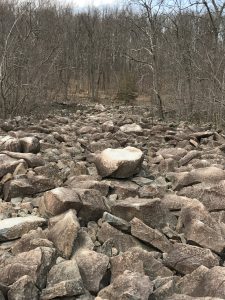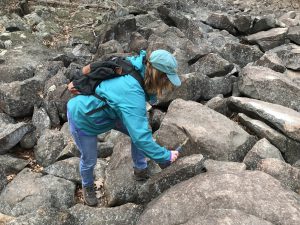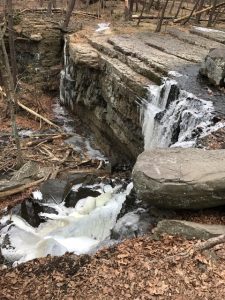Ringing Rocks Park (click here to visit park website)
Location: Upper Black Eddy, Bucks County, PA
Ringing Rocks Road, Upper Black Eddy, PA 18972

(map from Bucks County Department of Parks and Recreation, Ringing Rocks Park website)

Description
Ringing Rocks Park is a natural area managed by the Bucks County Park System of Pennsylvania. It’s famous for its boulder field with rocks that chime like bells. Visitors are allowed to hammer the boulders to make them ring. There is also a pretty waterfall that flows during wet seasons.
Visiting the Park
Was it worth the hour and a half drive to visit this park? Absolutely! This park is awesome. My two kids had a blast hammering rocks and climbing around the boulders. It was also priceless to see their expressions when they first hammered on the rocks. They couldn’t believe the sound.

Tips for Families
DO
- wear sturdy rubber-soled shoes or hiking boots
- bring hammers!
- bring water and snacks
- plan to stay for about 1 1/2 – 2 hours
- try to visit on a weekday – we went on a Monday and had the place to ourselves. I read that weekends can be crowded. Because it was a weekday, scenic NJ highway 29 that parallels the Delaware River was easy and quick. It was a beautiful way to get there.
DON’T
- come during rainy or wet weather (the rocks might be slippery)
- bring little kids (they might have trouble climbing around the rocks and may be more likely to fall and get hurt)
- lose your car keys in the boulder field

The waterfall at Ringing Rocks Park
Geology
(click here to visit Pennsylvania Geological Survey’s information sheet on Ringing Rocks Park)
Why do the Rocks Ring? No one knows exactly why. It was fun to test this for ourselves. Some of the rocks ring, and some don’t. You can hammer on a rock and get an incredible sound and the one next to it makes a lousy thud sound. For more information on this, I recommend looking at the Wikipedia post on Ringing Rocks (click here). It discusses some possible explanations. The article discusses a study that noted that ringing rocks expanded a little after being cut whereas the rocks that thudded did not expand.
The Big Picture: Ringing Rocks Park is part of a series of rift basins that formed during the Triassic Period along the east coast of the United States. When the supercontinent Pangaea began to split apart, rift basins formed and magma intruded into the basins. In some places, the magma reached the surface as lava. In places like Ringing Rocks, the magma stayed beneath the surface and formed the igneous intrusive rock, diabase. (At Ringing Rocks waterfall, you can see how the diabase magma cooled into layers known as sills. Its layered appearance looks sedimentary even though it’s an igneous rock.) Erosion has exposed these rocks at the surface now. The diabase rock is an incredibly dense, hard igneous rock. It is easy to see how it resists erosion.
Regional Map of Mesozoic Basins

This Diagram is from a USGS website on the Geology of Mesozoic Basins (click here to access this website). This website gives some nice background information on the diabase rock that formed in Ringing Rocks Park. (This figure was originally modified after highway map by the American Association of Petroleum Geologist, 1995).
